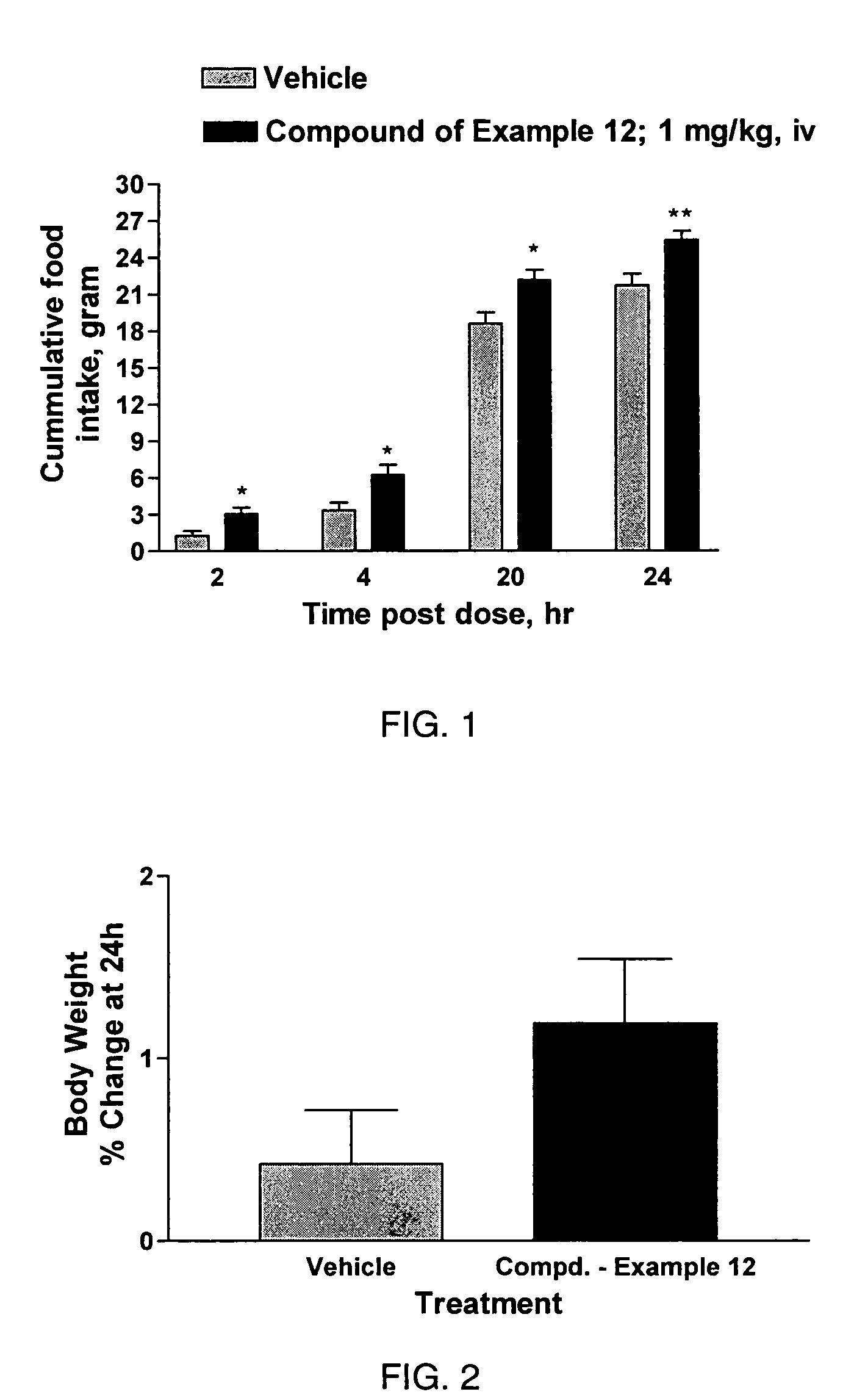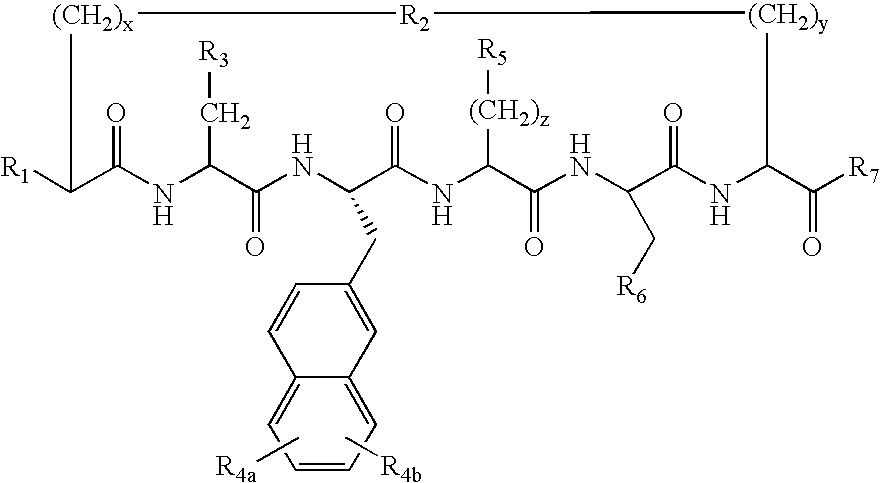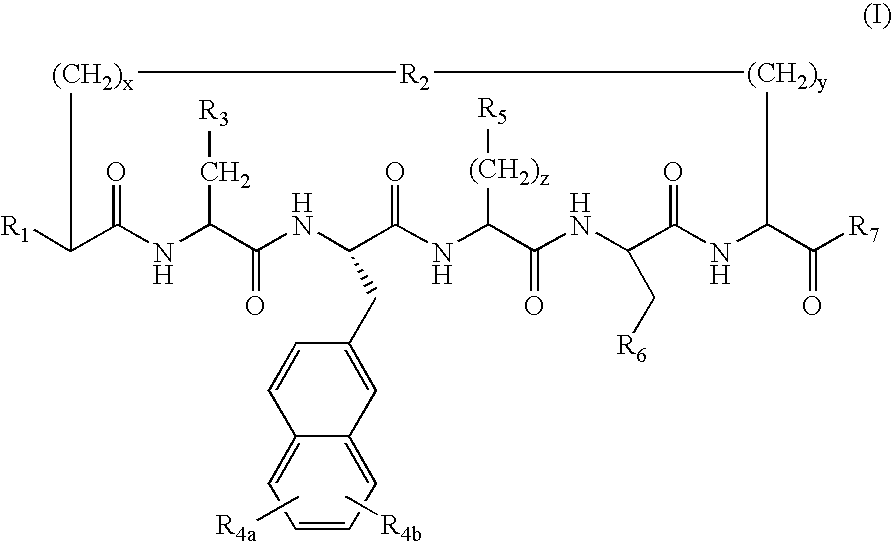Cyclic peptides for treatment for cachexia
a peptide and peptide technology, applied in the field of cyclic peptides, can solve the problems of obesity in mice, undesired loss of body weight, etc., and achieve the effects of low dose, efficacy, and efficacy
- Summary
- Abstract
- Description
- Claims
- Application Information
AI Technical Summary
Benefits of technology
Problems solved by technology
Method used
Image
Examples
example 1
Competitive Inhibition Assay Using [I125]-NDP-α-MSH
[0162]A competitive inhibition binding assay is conducted using membranes prepared using HEK-293 cells transfected with hMC3-R, hMC4-R or hMC5-R gene constructs, and B-16 mouse melanoma cells (containing MC1-R), using respectively 0.4 nM, 0.2 nM, 0.4 nM or 0.1 nM [I125]-NDP-α-MSH (New England Nuclear) in 50 mM HEPES buffer containing 1 mM MgCl2, 2 mM CaCl2, and 5 mM KCl, at pH 7.2. The assay tube also contains a chosen concentration of the test peptide of this invention, typically a 1 μM concentration, for determining its efficacy in inhibiting the binding of [I125]-NDP-α-MSH to its receptor. Non-specific binding is measured by complete inhibition of binding of [I125]-NDP-α-MSH in the assay with the presence of 1 μM NDP-α-MSH.
[0163]The assay mixture is incubated for 90 minutes at room temperature, then filtered and the membranes washed three times with ice cold buffer. The filter is dried and counted in a gamma counter for remaining...
example 2
General Method for EC50 Determination in Functional Activity Assay
[0164]Functional evaluation of peptides at melanocortin receptors is performed by measuring the accumulation of intracellular cAMP in HEK-293 cells expressing hMC3-R, hMC4-R or hMC5-R, and in B-16 mouse melanoma cells expressing MC1-R. Cells suspended in Earle's Balanced Salt Solution containing 10 mM HEPES (pH 7.5), 5 mM MgCl2, 1 mM glutamine, 0.1% albumin and 0.6 mM 3-isobutyl-1-methyl-xanthine, a phosphodiesterase inhibitor, are plated in 96 well plates at a density of 0.5×105 cells per well. Cells are incubated with the test peptides in the presence or absence of α-MSH for 1 hour at 37° C. cAMP levels in the cell lysates are measured using the EIA kit (Amersham). Data analysis and EC50 values are determined using nonlinear regression analysis with Prism Graph-Pad software.
example 3
[0165]The agonist / antagonist status with respect to MC1-R, MC4-R and MC5-R of certain peptides of the invention is determined. Antagonistic activity is determined by measuring the inhibition of α-MSH-induced or NDP-α-MSH-induced cAMP levels following exposure to the peptides as in the preceding descriptions.
[0166]Assay for agonist. Evaluation of the molecules to elicit a functional response in HEK-293 cells expressing hMC4-R for agonistic activity is done by measuring the accumulation of intracellular cAMP following treatment. Confluent HEK-293 cells over-expressing MC4-R are detached by enzyme free cell suspension buffer. Cells are suspended in Earle's Balanced Salt Solution containing 10 mM HEPES (pH 7.5), 1 mM MgCl2, 1 mM glutamine, 0.5% albumin and 0.3 mM 3-isobutyl-1-methyl-xanthine, a phosphodiesterase inhibitor. The cells are plated in a 96 well plates at a density of 0.5×105 cells per well and pre-incubated for 30 minutes. The cells are then challenged with ...
PUM
| Property | Measurement | Unit |
|---|---|---|
| pH | aaaaa | aaaaa |
| pH | aaaaa | aaaaa |
| particle size | aaaaa | aaaaa |
Abstract
Description
Claims
Application Information
 Login to View More
Login to View More - R&D
- Intellectual Property
- Life Sciences
- Materials
- Tech Scout
- Unparalleled Data Quality
- Higher Quality Content
- 60% Fewer Hallucinations
Browse by: Latest US Patents, China's latest patents, Technical Efficacy Thesaurus, Application Domain, Technology Topic, Popular Technical Reports.
© 2025 PatSnap. All rights reserved.Legal|Privacy policy|Modern Slavery Act Transparency Statement|Sitemap|About US| Contact US: help@patsnap.com



